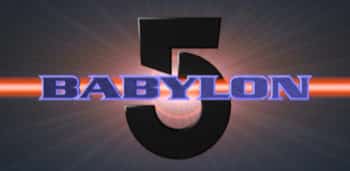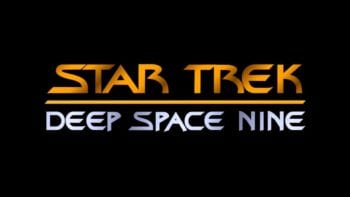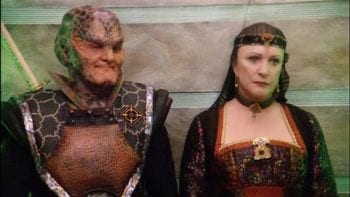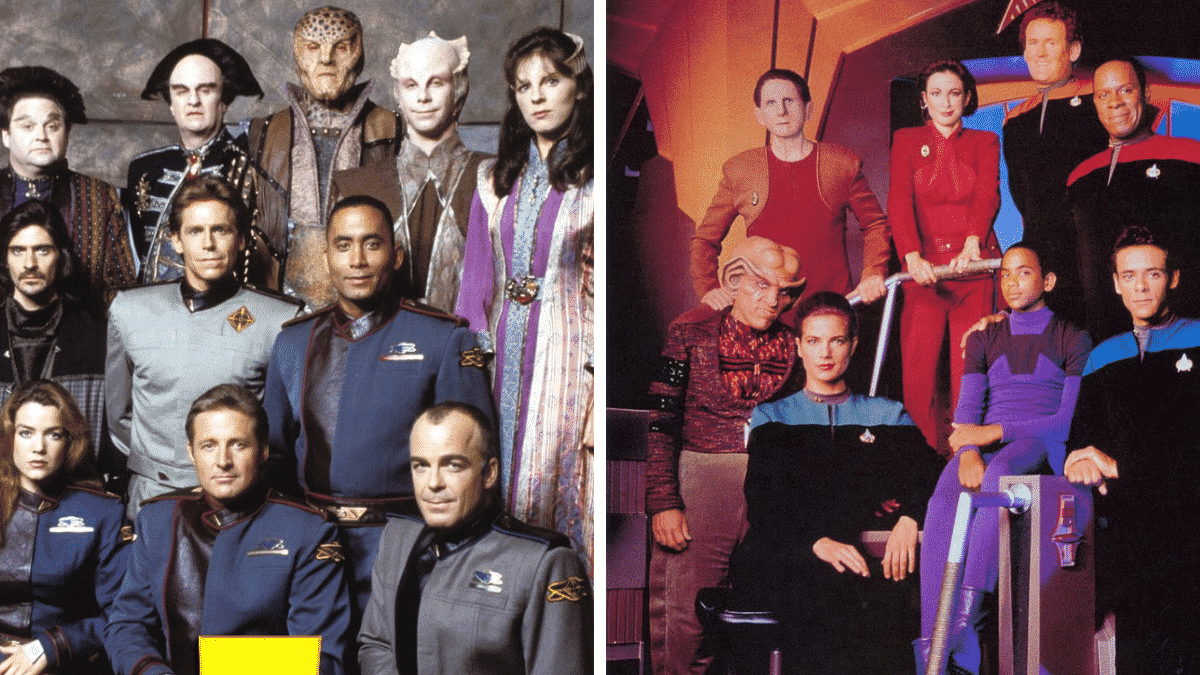Understanding the Babylon 5 vs. Deep Space Nine Plagiarism Allegations
I'm sure this won't cause any negative reactions at all...

1993 was a banner year for fans of space station-based science fiction. Not one but two prominent series got their start that year.
The first, Star Trek: Deep Space Nine, a continuation of the long-running Star Trek franchise. The second, Babylon 5, a brand new universe and IP by J. Michael Straczynski (often referred to as JMS).
But while the two series would both go on to become beloved sci-fi classics, their beginnings were much more tumultuous with allegations of plagiarism causing a rift between the two shows that led to more than a few heated exchanges.
Though those differences appear to be resolved between the shows themselves, it’s an issue that has divided science fiction fandom and remains a sore spot for many nearly 30 years later.
So what happened and why do so many science fiction fans believe Deep Space Nine was a plagiarism of Babylon 5? The answer is a long, winding story that actually starts nearly a decade before either show made it to air.
The Background of the Two Shows

The story of the shows actually begins in the mid-1980s. JMS, frustrated with shows running over budget and a long-time fan of science fiction sagas, began work on a treatment and a “Bible” for Babylon 5.
The idea for the show was straightforward. It was going to be a more realistic science fiction series that would feature a single overarching plot that would be told over multiple seasons. JMS viewed it as a novel in television format and wrote it accordingly.
By 1988 he was pitching the show to various networks. Among those was Paramount, which JMS approached sometime in the summer of 1989. JMS also approached Warner Bros. with the project and they were the ones to eventually pick it up for their new Prime Time Entertainment Network (PTEN). This was announced formally in 1991 November.
(Note: In 2013 a commenter alleged that Paramount and Warner Bros. were working on a network together around the time both shows were being developed. However, I’ve not been able to find any independent confirmation of this.)
However, 1991 was also the year that things got rolling for Deep Space Nine. Recently hired President Motion Picture Group for Paramount Brandon Tartikoff approach Star Trek writer and producer Rick Berman about the idea of expanding the show to another series to run parallel and after Star Trek: The Next Generation.
According to reports, executives were not comfortable with having two ship-themed shows and opted for a space station as a way to cut down costs. They also wanted a darker and more serious series.
Deep Space Nine began production in 1992 and Babylon 5 began production on its pilot movie at about the same time. However, Babylon 5‘s first full season wouldn’t begin airing until 1994, a full year after Deep Space Nine would begin. As a result, JMS began to get worried that, even though he had been working on his series for nearly a decade at this point, it would be seen as a cheap knock off of Star Trek.
“I know full well that even if the Warners PR machine got working 24 hours a day on this, half of all viewers will see this show, coming out after DS9, and think it’s just a last-minute knockoff or ripoff of DS9”
JMS, September 1992
Similarities between the two shows (and the fact that Paramount had access to the Babylon 5 Bible) quickly led to allegations of plagiarism.
However, even though the war of words was often heated, it never spilled into legal action. JMS, for his part, saw such a lawsuit as being nonproductive and felt it would only harm both shows.
(Note: In 2017 Patricia Tallman, who played Lyta on Babylon 5 and was JMS’ romantic and business partner for much of the 2000s, claimed in an interview that there was a lawsuit and it was settled out of court. However, I’ve been unable to find any legal fillings but have found many sources where JMS said that a lawsuit wouldn’t have been productive. Still, it does not mean there was not a serious threat of a lawsuit.)

Eventually, the two shows would establish their own unique identities despite their somewhat similar concepts. The two shows even reached peace with each other with Majel Barrett, the “first lady of Star Trek” and widow to the series creator Gene Roddenberry, guest-starred in an episode of Babylon 5. Babylon 5 actor Bill Mumy did the same on Deep Space Nine.
The two shows also shared friendly softball games and seemed to get past the initial animosity.
That said, the fans were not so quick to let go of things.
Even now, nearly 30 years later, fans still debate the issue of whether Paramount plagiarized Babylon 5 when producing Deep Space Nine. Though most feel that both shows were great, the great plagiarism debate has never died down with fans arguing about if and how much was copied between the shows.
The Allegations
The allegations of plagiarism are literally too long to even effectively outline here. Many sites have done deep dives into the similarities between the shows and have found hundreds of things to point to.
The alleged similarities range from the very superficial to the very detailed and cover a wide range of the shows’ runs. Examples include:
- Names of the Shows/Stations: Both are Name of Station + a Number
- Character Names: Both Shows feature characters with names pronounced as Lyta and Dukhat but with different spellings.
- Villains: Both shows feature shadowy external threats that seem to take over the region both through military might and internal manipulation.
- Captains: Both stations had captains that were religious leaders for an alien race, dated freighter captains and ultimately disappeared.
- Purpose of the Station: In both cases, the space station is intended as a place for diplomacy and trade.
The list goes on and the similarities vary wildly in how convincing they are.
However, the allegations aren’t necessarily that this is a straightforward kind of plagiarism. One thing that has remained consistent is that no allegations were ever hurled at Rick Berman and Michael Piller, the creators of Deep Space Nine.
“have never, ever felt, or believed, or thought, that Berman or Pillar (sic) EVER saw or knew about the B5 information. Had anyone suggested anything of a less than straightforward nature, they would have refused; of that I have no doubt.”
JMS, June 1995
Instead, the allegations were that Paramount executives were aware of Babylon 5 and steered the show to be more like it. It isn’t that Deep Space Nine was written to be a Babylon 5 rip off, but that executives used their creative control to bring elements from the show they liked to Deep Space Nine.
However, that is belied by the fact that many of the similarities seem very pointed and include names and specific plot points. If the writers and producers of Deep Space Nine were, by all accounts, unaware of Babylon 5 at the start of production, at what point could those similarities have been introduced?
In short, it’s pretty much impossible to claim that all of these similarities were the result of plagiarism while also vindicating the writers and producers of the show. Though executives can and do exert creative control, it rarely has this fine of a touch.
However, this awkward conundrum is easily avoided by simply looking away from the similarities and toward the differences.
My Personal Take
Disclosure: I am a long-time fan of Star Trek but am still new to Babylon 5, only recently finishing the main series. However, I’ve enjoyed both shows and don’t have an axe to grind with either.
Back in September 2018, I created my own fake plagiarism story comparing The Rocky Horror Picture Show to, ironically enough, an episode of Star Trek. The goal was to show how easy it is to look at just the similarities between two works and see plagiarism.
Though the two shows are both science fiction shows that take place on a space station and feature a single plot thread that carries throughout the run, they are still very different shows.
Babylon 5 can almost be described as a dystopian show. Though it has a hopeful message, the universe its set in doesn’t put much faith in humanity. Meanwhile, Deep Space Nine is part of the Star Trek universe and takes a much more optimistic look at humanity’s future, even if it is set during a war that is often bleak.
The writing was also drastically different. Though Deep Space Nine did feature a series-long arc, it also had many standalone episodes. With Babylon 5, every episode was a chapter in the story and drove that plot forward in some way (though often small).
Watching the two series close together, they have very different tones. Though Deep Space Nine was clearly darker and heavier than any Star Trek prior to it, that still doesn’t put it in the same league as Babylon 5 in that area.
Even many of the most pointed similarities ignore crucial differences. The fact that there were two characters name “Lyta” (though with different spellings) belies the fact they are very different characters. The Babylon 5 one is a powerful telepath that plays a key role in the war, the Deep Space Nine one is a dabo girl (basically a cocktail waitress at a casino) that was mostly seen as a romantic interest.
Other similarities are likely the product of having two shows with similar premises being made at the same time. It’s logical that space stations are going to be near interstellar travel points (especially for the purpose of plot) and that they will be homes for commerce and diplomacy. It would be difficult to have a space station show without that.
Even the inclusion of shapeshifters in both (albeit only in one episode of Babylon 5) can be attributed to the popularity of Terminator 2, which was released in 1991.
And that’s the key problem. Once you strip away the things that could be just coincidence, the items that literally come from producing this kind of show at this point in history and items where major differences are ignored, you’re not left with much.
Even if the two shows had a completely independent creation, they would have been extremely similar. Two science fiction shows about space stations made in the early 90s were always going to have a lot of overlap.
Ultimately, despite their similarities, the two shows ended up being very different. Babylon 5 a true hard sci-fi with more dystopian overtones and Deep Space Nine a slightly-darker Star Trek series complete with the usual technobabble and optimism that comes with it.
For all the things they do share, it’s what separates them that makes them both great and special.
Bottom Line
It’s interesting that, after nearly 30 years, fans still passionately and even angrily debate this topic. Long, long after the shows’ creators have buried the hatchets and found their own voice, the fans keep it alive.
The fact of the matter is both shows managed to carve out their own niche and find their own success. They did this by not being similar to one another but being far enough apart that direct comparison, while still a common activity for fans, is almost impossible.
We live in a world where two characters named Dennis the Menace debuted on the exact same day on opposite sides of the Atlantic. Coincidences do happen and, if we’re to believe that the details we explored are plagiarisms, we have to implicate the people who actually worked on the show, which no one has.
That said, we will never really know for certain how much (if any) influence Babylon 5 had on Deep Space Nine. To me, the most likely thing that happened was that Babylon 5, especially it being picked up by Warner Bros. pushed Paramount’s executives to create a darker, harder and more saga-like version of Star Trek.
Paramount, understandably, didn’t want to fall behind when it came to science fiction and saw the broad strokes of what Babylon 5 was trying to do as a path forward. But that is pure speculation at best and a far cry from making Deep Space Nine a “rip off” or a plagiarism of Babylon 5.
If Babylon 5 pushed Star Trek to innovate on their formula, that is ultimately a good thing. Both shows pushed science fiction on television forward and both brought their own voice to the genre.
For all of the talk about their similarities, it’s their differences that really make them shine.
Want to Reuse or Republish this Content?
If you want to feature this article in your site, classroom or elsewhere, just let us know! We usually grant permission within 24 hours.
